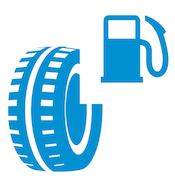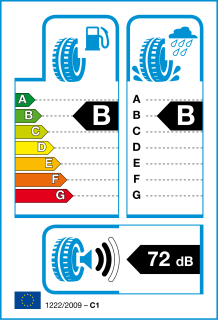
Guide to Tyre Energy Efficiency Ratings
As you may or may not know, as of November 2012 it became a legal requirement for every tyre in the EU to come with an energy rating chart (as seen below). The tyre label testing is self-certified using specific EU standardised methods that every test must follow.
The energy rating chart takes three very important factors into consideration and these are:
- Fuel Efficiency
- Wet Grip
- External rolling noise
This chart is graded from A to G, with A being the highest performing tyre and G being the least performing.
Fuel Efficiency

The grades given to tyres for their fuel efficiency are given based on the energy that is lost when a tyre is rolling – also known as ‘rolling resistance’. The tyres that you put on your car can affect its fuel economy by up to 20% and a lower rolling resistance reduces fuel consumption and CO2 emissions, helping a tyre achieve it’s A grade.
You should always take fuel efficiency into consideration when purchasing new tyres as they may save you some money! Grade G tyres could end up using 6 litres more fuel for every 625 miles that you drive than if you fitted A rated tyres.
When scoring tyres for their fuel efficiency, the EU Tyre Regulation doesn’t use D as a grade as this helps to differentiate the top and bottom three grades.
Wet Grip

The information provided on the wet grip label is an extremely important safety aspect to look at when purchasing new tyres as this informs you of how well your tyres will grip to the road in wet weather.
Tyres with excellent grip on wet roads have a shorter braking distance. Tyres that don’t offer such a good drip have a longer braking distance and the stopping distance between each grade is roughly 3m (the average length of 1 car). Therefore, purchasing tyres that are at the top end of the spectrum provide you with an important safety benefit when driving.
Similarly to the fuel efficiency, grade D is not used whether measuring a tyre’s grip in wet weather, and there are also no current plans from the EU to use G either.
Noise Levels

The tyre’s exterior noise is graded by decibels and in addition to this there is an image which shows whether the tyre external rolling noise is above the future European mandatory limit value. One black wave indicates the best noise level which is at least 3db below the future legal limit, and three black waves show the weakest performance, which is also illegal and over the European noise limit.
At MQ Tyres we are proud stockists of Nexen and GT tyres – both of which are known for their excellent energy efficiency ratings and great value for money!
To find out more, please contact the team on 01234 327 328.
Image source: The EU Tyre Label – Tyre Technical Information – GOV.UK

